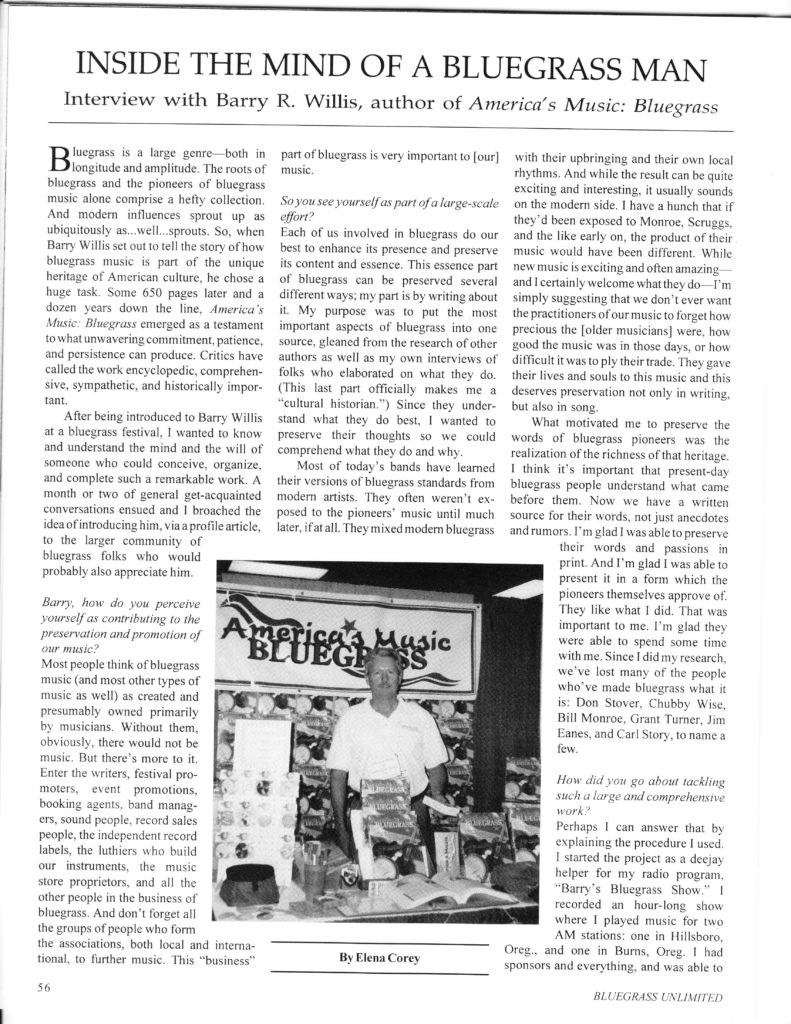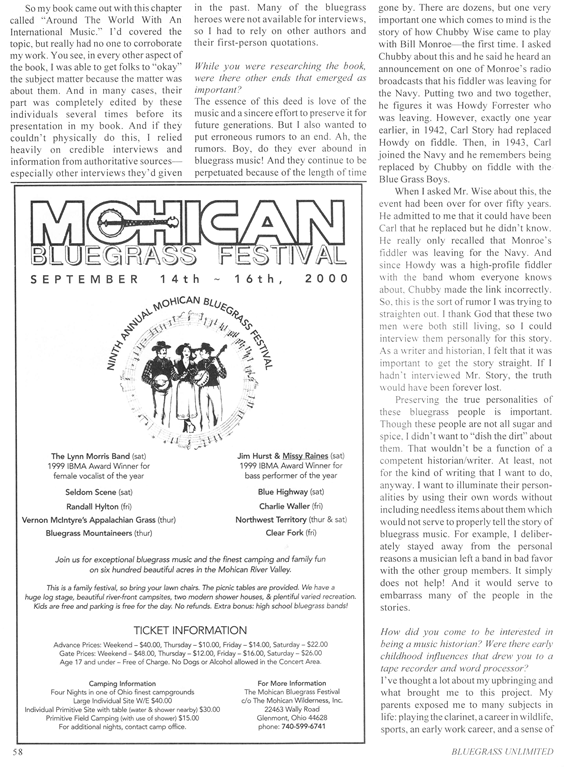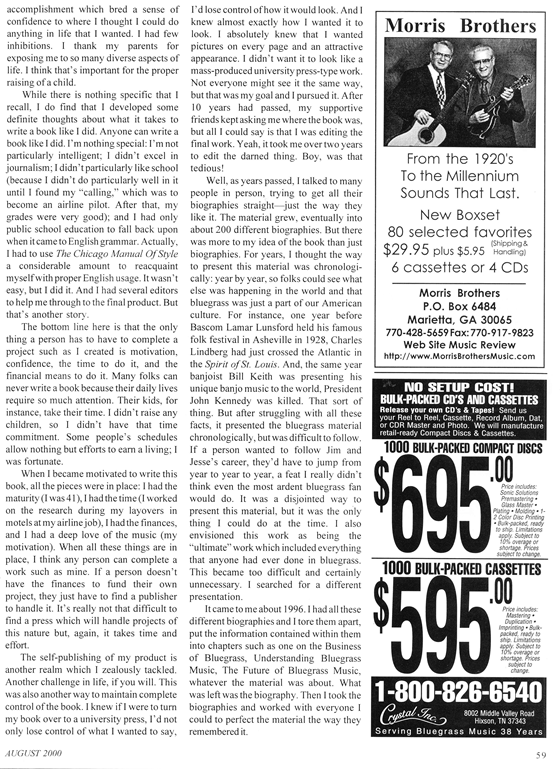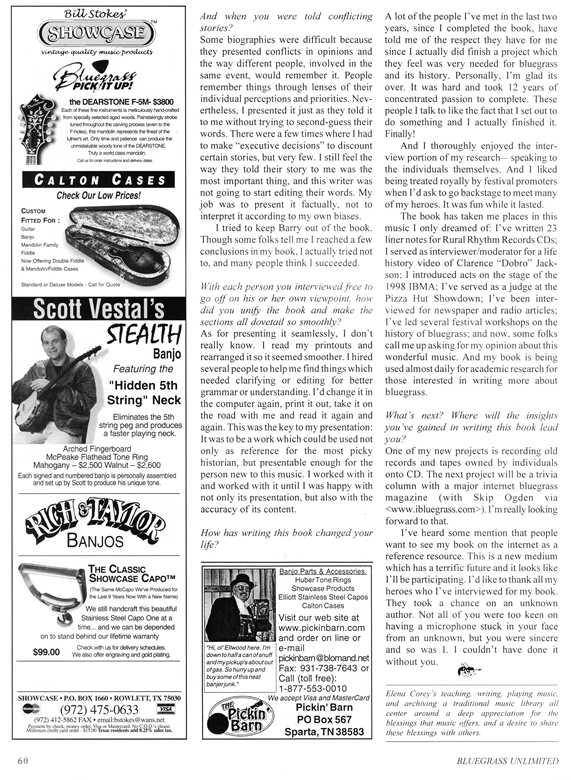
For you who are new to America’s Music: Bluegrass, A History of Bluegrass in the Words of Its Pioneers, it is a 1997 publication and concentrates on what our pioneers told us about this music. The book is not a up-to-date presentation of this music or its artists. It is meant to help a person understand what bluegrass music is, how it came about, how difficult these pioneers had it back in the formative days of this music. These stories are in their own words, with no agenda from the author of this book: Barry R. Willis. This concept is very important to the pioneers for they wanted me to tell their stories, not distorted by the editing of a creative writer. Many of the pioneers told me that they appreciate this concept. You can see their comments in the section of “What They Say About This Book.”
To download this book, please click HERE
Acoustic Spotlight – Barry Willis
by Phyllis Stark
Barry Willis is the kind of person you want to pilot your plane. In fact, Captain Willis may have flown a plane you were on. He flew for United Airlines for nineteen years before retiring in 2005. Barry is thorough, a stickler for detail and a man of perseverance. Those are important traits for a pilot. They are also great characteristics for writing a massive book on everything to do with bluegrass music. America’s Music: Bluegrass (AMB) is Barry’s six hundred and thirty- page work. “It took twelve years of concentrated passion to complete.” It contains four hundred and twenty photos and about two hundred biographies. The first edition came out in 1997, the second a few months later.
Barry began pulling information together in the early 80s as a deejay helper for his syndicated radio shows in Burns and Hillsboro, Oregon. Barry studied available books on the history of bluegrass but ultimately found them lacking. “There were all kinds of questions that needed answers. I loved the music so very much, loved the people who played it and appreciated what it takes to be an accomplished musician.”
Barry decided someone needed to fill in the gaps and determined to do it himself. “We don’t ever want to forget how precious the older musicians were, how good the music was in those days or how difficult it was to ply their trade. They gave their lives and souls to this music.” Most could not make a living playing the music full time. They toured a few weeks or months then returned home to work and save money for another tour. Bill Monroe bought his own tent, hired a crew and traveled with everything he needed to do his shows. That way he could save venue costs and pay his band. But as Barry pointed out to me “even though many bluegrass bands were doing well, folks like Elvis came on the scene and took a huge bite out of the money people had available to spend on music. They went electric too and could play to larger crowds.”
Barry’s journey to discover bluegrass history was quite entertaining since he loves the music and likes to be in the company of bluegrass musicians. It required a large dose of tenacity, too. He needed an open mind, curiosity and the ability to step back and take another tack when he heard conflicting viewpoints. Barry attended festivals from coast to coast and interviewed hundreds of musicians. He listened to first person accounts and sought to corroborate them with third person interviews. Occasionally the story did not jibe with other known facts but Barry saw his job as presenting the information factually as told to him and not putting forth his own opinions. “Some biographies were difficult because they presented conflicts in opinions and the way different people involved in the same event remembered it. Nevertheless I presented it just as they told it to me without trying to second-guess their words. I feel the way they told their story to me was the most important thing. I tried to keep Barry out of the book.”
I’ve listened to an interview Barry conducted with Curly Seckler. I believe Barry’s mild manner was one of the main reasons folks agreed to talk with him. He asked a question and let the person speak without interruption. Another courtesy was to allow every person to review the text of their conversation and approve it before it was published.
AMB consists of twenty-six chapters ranging from information about bluegrass instruments, festivals and the bluegrass music industry to women in bluegrass and new types of bluegrass music. It is used for reference by people doing academic research on bluegrass music and by just about anyone wanting to learn more about the genre. Barry leads workshops on the history of bluegrass and has been interviewed extensively on the subject. “I thoroughly enjoyed the interview portion of my research — speaking to the individuals themselves. I liked being treated royally when I asked to go backstage to meet many of my heroes. I am thankful to all those I interviewed for the book. Not all were too keen on having a microphone stuck in their face but they took a chance on an unknown.” Barry told me “folks were really generous with their time. They spoke with charity and almost all of them had an interest in getting the information down correctly. They wanted the story to be told. It was the most accurate thing we could create together. Some had previous bad experiences with writers but they still trusted me.”
Barry a now live sin Kailua-Kona, Hawaii. He created the Gospel Jamboree and Pie Supper founded to benefit the homeless shelter at the First Baptist Church in Denver. In Hawaii they hold the Willis Saturday Jam at their home once a month. They like the Hawaiian lifestyle and seldom leave the islands.
Don’t think Barry is finished with the history of bluegrass project just because AMB is published. He knows what treasures he has in his possession. Barry is conservator of original interview recordings by hundreds of our bluegrass ancestors. He plans to share them in audio version. Barry has converted the tapes to digital format. In a groundbreaking move he will release them as an interactive DVD called Bluegrass Heritage Interactive. AMB will be on the DVD and you will be able to click on links to hear all of the over two hundred first person interviews. Links to recordings, photos, videos and other pertinent information will also be part of the package. Thus the viewer can get a complete picture of what the artist was like. I found the Seckler interview fascinating and felt a much stronger connection to him after hearing it even though I had read some of the same interview. Don’t worry, I will keep you posted on the progress of Barry’s new project. You can also find out more about it at pwww.barryrwillis.com.
America’s Music: Bluegrass recognizes the role of everyone in bluegrass: promoters, producers, musicians, and anyone with connections to the preservation and enjoyment of the music. We can be grateful Barry chose a job for himself and carried it out. Because of him we have priceless treasures from the past. Many bluegrass icons are no longer with us but their own words continue to tell the story — thanks to Barry.
Phyllis Stark
Unless otherwise noted all quotes are from Elena Corey’s interview with Barry published in Bluegrass Unlimited in 2000.





